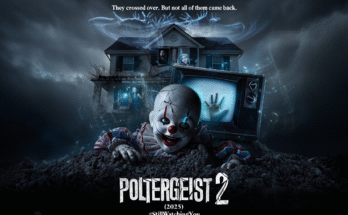Fog rolls over the cobblestones of Victorian London like a living memory, heavy with regret. In A Christmas Carol (2026), director Ti West reshapes Dickens’ classic into a haunting meditation on guilt, grief, and redemption — not through sentiment, but through shadows.

Johnny Depp’s Ebenezer Scrooge is no mere miser counting coins by candlelight. He’s a haunted man — hollow-eyed, trembling beneath the weight of years he can’t undo. Every creak of the floorboards feels like a heartbeat he’s tried to forget, every flicker of flame a face from his past.
When the bells toll and the dead begin to stir, the film shifts from period drama to psychological horror. Helena Bonham Carter’s Ghost of Christmas Past drifts through his memories with ethereal grace — less angel, more omen. Her presence glows with sorrow, her voice trembling between lullaby and lament.

Ralph Fiennes, as the Ghost of Christmas Yet to Come, delivers pure cinematic terror. His silent movements, cloaked in mist and despair, embody the inescapable truth of mortality. He doesn’t haunt Scrooge to teach him — he judges him.
Ti West’s direction turns the familiar tale into something unrecognizably beautiful and chilling. The camera moves like conscience itself — slow, unrelenting, intimate. Every corridor seems endless, every whisper feels like confession. The result is not comfort, but confrontation.
Visually, the film is gothic poetry. Candlelight burns against decaying wallpaper, snow falls like ash, and London feels less like a city than a soul unraveling. The production design captures the duality of beauty and rot — a perfect mirror for Scrooge’s heart.

Depp’s performance is one of quiet devastation. Gone are the caricatures of greed; instead, we see a man drowning in what-ifs. His eyes speak the language of loss long before words leave his lips. He isn’t learning compassion — he’s remembering it.
Helena Bonham Carter’s spectral tenderness and Ralph Fiennes’ merciless stillness form the film’s emotional axis — the feminine ache of empathy colliding with the masculine terror of judgment. Between them, Scrooge is torn apart, rebuilt, and reborn.
The score — a blend of low strings, echoing choral hums, and distant clockwork — gives the film its heartbeat. Each note drips with dread and melancholy, reminding us that redemption is not given freely; it must be earned through pain.
By the time dawn breaks, and Scrooge collapses beneath the weight of grace, the audience doesn’t cheer — they exhale. His salvation feels less like joy, more like survival. The lesson isn’t that Christmas changes him, but that it finally forgives him.
“Three ghosts. One night. A lifetime of guilt.” Ti West’s A Christmas Carol (2026) is a haunting masterpiece — not of horror, but of humanity. It doesn’t warm your heart; it chills your soul… and somehow, that’s the truest Christmas miracle of all. 🕯️



